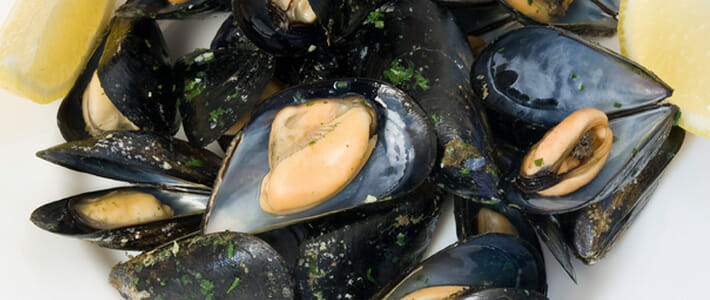Mussels, Mediterranean (Blue)

Mediterranean mussels, also known as the black mussel, the cultured blue mussel is uniform in size (average of 3.5 inches) and has a thin, dark shell. The meat is cream-colored to apricot, depending on gender.Belonging to the Mytilidae family, the blue mussel is the most common edible mussel in the northern hemisphere. Rope-cultured mussels can grow up to five times faster and have three times the meat than wild mussels. The quality between wild and rope-cultured mussels varies greatly. Wild mussels have smaller meat and thicker shells. Rope-grown mussels contain no sand; cultivated mussels must be purged to rid the meat of sand.
Product pdf for download-
1 cup (150g) raw edible portion
-
Calories 129
-
Calories from Fat 11.02
-
Total Fat 3g
-
Saturated Fat 1g
-
Cholesterol 42mg
-
Sodium 429mg
-
Total Carbohydrates 6g
-
Protein 18g
Texture
The texture of blue mussels is muscular and firm.
Preparation
Blue mussels can be steamed in water, wine, or broth. The meat is good fried, baked, sautéed, and served as an appetizer in soups, salads, and pasta dishes. Use 12 mussels per person for appetizers and 25 per person for a main course
Interesting Fact
The entire world harvest of all edible mussel species in 1992 was 2.7 billion pounds, live weight. Because they are filter feeders, it is important that mussels are harvested from clean, unpolluted waters. Live mussels must be certified as being safe by the government and come with a tag identifying the shipper and date of harvest. Cultivated mussels, or those from prime quality wild beds, have thin, light, jet black shells and greater meat yields than their wild counterparts.
Alternatives
An alternative to blue mussels are green lip mussels.
Source
Mussels are harvested in temperate waters around the world. In the US and Canada they are harvested off of both coasts. They are also harvested in the Atlantic from Holland to Spain as well as in the Mediterranean Sea.
Harvest Method
Blue mussels are either harvested in the wild or farmed on ropes, in pots, or mussel parks.
Harvest Season
Blue mussels are available year-round with peak production from October through May.
Flavor
Blue mussels have a rich and sweet flavor.
Market Segments
Mussels are appropriate for casual dining, fine dining, hotels, and resort/clubs.